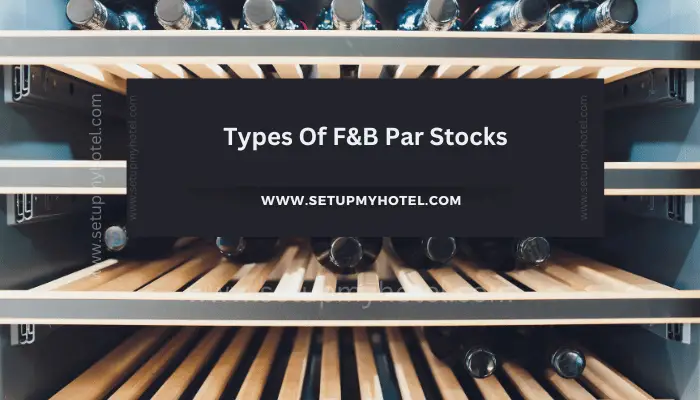What are the types of Food & Beverage Par Stocks
The food and beverage industry, “par stock” refers to the standard quantity of a particular item that should be on hand to meet the needs of a business during a specific period, often a day or a shift. Par stocks are crucial for maintaining inventory control and ensuring that a restaurant or bar has a sufficient supply of ingredients to fulfil customer orders without running out or overstocking.
For food and beverage establishments, par stocks are typically established for various categories of items, such as food ingredients, beverages, utensils, and disposables. The determination of par stocks is influenced by factors such as historical consumption patterns, sales volume, menu items, and the frequency of deliveries.
Here’s how par stocks function in different areas of the food and beverage industry:
- Food Ingredients:
- Par stocks for food ingredients ensure that the kitchen has a sufficient supply of essential items to prepare menu items. For example, if a restaurant uses a specific sauce in multiple dishes, the par stock for that sauce would be set to meet the expected demand.
- Beverages:
- In bars or restaurants with a beverage service, par stocks are set for various types of alcohol, mixers, and other drink ingredients. This helps prevent shortages during busy periods and ensures a consistent quality of service.
- Utensils and Disposables:
- Par stocks extend beyond food and drink items to include utensils, napkins, and other disposables. Having a predetermined quantity of these items helps in managing operational needs efficiently.
Establishing and maintaining par stocks involves a careful balance to avoid unnecessary holding costs associated with excess inventory and potential disruptions due to insufficient supplies. InventoryDefinition of Inventory in Hotel Operation? Inventory is the stocks of merchandise; operating suppli... management systems and regular monitoring help businesses adjust par stocks based on changing demand patterns, seasonal variations, and other factors.
For example, if a restaurant experiences increased demand for a particular dish during a certain season, the par stock for ingredients used in that dish may be adjusted upward to accommodate the higher demand.
1. F&B Par Stock-Guest Supplies
- To control the amount of stock held in the outlets at a given moment
- GuestDefinition of Guest in Hospitality Industry: A guest is the most important person in any business. A... Supplies Par Stock will apply to all F&B Outlets and Sections.
- F&B Par Stocks will not be altered or changed without the prior approval of the Director of F&B
- All Requisitions will be taken into account quantities ordered to meet Par Stock Levels.
2. F&B Par Stock-Stewarding
- To control the amount of stock held in the outlets at a given moment
- Stewarding supplies Par Stock will apply to all F&B Outlets and Sections.
- F&B Par Stocks will not be altered or changed without the prior approval of the Director of F&B
- All Requisitions will be taken into account quantities ordered to meet Par Stock Levels.
3. F&B Par Stock-Chemicals
- To control the amount of stock held in the outlets at a given moment
- Chemical supplies par stock will apply to all F&B Outlets and sections.
- F&B par stocks will not be altered or changed without the prior approval of the Director of F&B
- All requisitions will be taken into account quantities ordered to meet Par Stock Levels.
4. F&B Par Stock-Linen
- To control the amount of stock held in the outlets at a given moment
- Linen Par Stock will apply to all F&B Outlets and Sections.
- F&B par stocks will not be altered or changed without the prior approval of the Director of F&B.
- Par stock levels must be taken into account when quantities are requested and are to be approved by the Director of F&B.
Efficient par stock management contributes to cost control, reduces waste, and ensures a smoother operational flow in the food and beverage industry. Regular assessments and adjustments to par stocks help businesses optimize their inventory levels and respond effectively to changes in customer demand.











